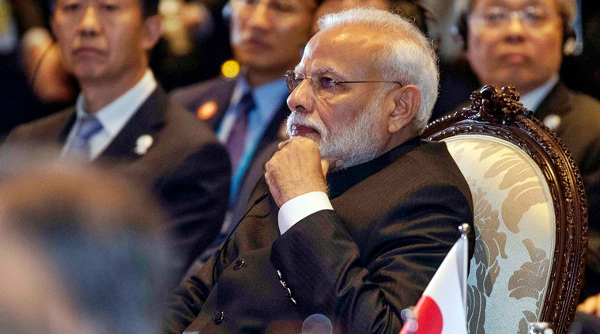Prime Minister Narendra Modi said in his address at the RCEP summit in Bangkok that India cannot join the present form of the RCEP Agreement as it does not fully reflect the basic spirit and the agreed guiding principles of RCEP.
The Regional Comprehensive Economic Partnership (RCEP) is a mega-regional economic agreement being negotiated since 2012 between the 10 ASEAN (Association of South-East Asian Nations) governments and their six FTA partners: Australia, China, India, Japan, New Zealand and South Korea.
RCEP is largely driven by ASEAN. Indeed, the project originated in, and expands upon, the stitching together of five existing ASEAN+1 trade agreements, that ASEAN signed with Japan, South Korea, China, India, Australia and New Zealand. The goal of the negotiations is to boost economic growth and equitable economic development, advance economic cooperation and broaden and deepen integration in the region through RCEP. From what is known of the agreement’s contents, the proposed RCEP would cover almost every aspect of economy such as goods, services, investment, economic and technical cooperation, intellectual property rights (IPR), rules of origin, competition and dispute settlement.
The negotiations have missed several deadlines repeatedly, even though they have gained momentum since 2016.There are many reasons for India’s pull from this alliance.
India’s economy is passing through a difficult time. The rate of GDP growth has been slowing down for five consecutive quarters. This Combined with demonetisation move in November 2016, the GST rollout is yet to fully come to terms with these two key decisions.
As the industry is reeling under pressure and a massive free trade pact like RCEP would have exposed the Indian businesses and agriculture to unequal competition from countries which are giant in the export arena.
India has massive trade deficits with almost all economic giants of the world. Of the 15 RCEP countries, India has serious trade deficits with at least 11.India’s trade deficit with these countries has almost doubled in the last five-six years – from $54 billion in 2013-14 to $105 billion in 2018-19. In such export-import equation a free trade agreement with the grouping would have increased it further.
At present, India has around 20 per cent of all its exports to the RCEP countries and receives 35 per cent of all imports from them. China is the leader of this export-import circle. It is the largest exporter to almost all countries of the group, including India. Of India’s $105 billion trade deficit with RCEP countries, China accounts for $53 billion. Widening trade deficit would empty foreign exchange reserve of India at a faster rate. And, a depleting foreign reserve is never good for any economy and is least desirable for the one trying to recover.
RCEP has been opposed by both the industry and farmers both. Manufacturing sector in India is in crisis. The sector has seen slowdown in recent months. Manufacturing output grew at its slowest pace in two years. Services sector is also not doing well, of late. China and ASEAN countries have good service sector, and a free entry to these players may damage the lone saviour of Indian economy in these times of crisis.
In agriculture, domestic players dealing in dairy products, spices — chiefly pepper and cardamom, rubber, and coconut would face tough competition from the South Asian spice majors. Sri Lanka is already giving a tough time to Indian spice growers.
Vietnam and Indonesia have very cheap rubber to export. Australia and New Zealand are looking for a free access to India for their dairy products. Indian businesses would suffer a lot as RCEP does not offer good protection to them.
RCEP has come up as a Chinese strategy to save its manufacturing industries from crumbling under their own weight. Several industrial players in India flagged the Chinese agenda of flooding the Indian market using the RCEP countries as a connecting network.
China has already covered most markets under RCEP. ASEAN-6 (Indonesia, Malaysia, Philippines, Singapore, Thailand and Vietnam) had a trade surplus of $53 billion in 2010 which turned into a trade deficit of $54 billion in 2016.
India, with its 1.3 billion populations offers the biggest free access market to the Chinese companies that are feeling heat of US-China trade war.
China needs greater access to Indian market to sustain its manufacturing industries. A failure to find a market will have cascading effect on Chinese economy and President Xi Jinping’s global ambitions.
Make in India is definitely the flagship project to attract foreign investment; this was never conceived at the cost of domestic industry. Even after thirty years of economic reforms, Indian manufacturing are yet to be competitive enough to face the competition brought about by international trade.
As for RCEP, India must keep its doors open for possible future engagements. For this, RCEP can be seen as a grouping where India can negotiate the details of its entry. The bargaining should be such that it gives India a fair chance of stable growth and managing a transition to better opportunities.
Source: DE
Image Courtesy: IGJ
You may also like
-
Trade Connect E-platform For Exports Is Single Window, Fast, Accessible And Transformational: Shri Piyush Goyal
-
Dot Simplifies Approval Processes For Telecom Licenses And Wireless Equipment
-
Coal Production and Supply Trends on Positive Trajectory
-
Union Minister To Release Booklets On Promotion Of Indigenous Species & Conservation Of States Fishes
-
2nd India-Japan Finance Dialogue held in Tokyo on 6th September, 2024
